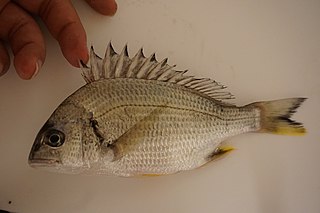
Siniperca chuatsi, the mandarin fish, is a species of freshwater ray-finned fish from the family Sinipercidae, the Oriental perches. It is the type species of the genus Siniperca.

The tench or doctor fish is a fresh- and brackish-water fish of the order Cypriniformes found throughout Eurasia from Western Europe including the British Isles east into Asia as far as the Ob and Yenisei Rivers. It is also found in Lake Baikal. It normally inhabits slow-moving freshwater habitats, particularly lakes and lowland rivers.
Sinocyclocheilus is a genus of freshwater fish in the family Cyprinidae that is endemic to Guangxi, Guizhou and Yunnan in China. Almost all of its species live in or around caves and most of these have adaptions typical of cavefish such as a lack of scales, lack of pigmentation and reduced eyes. Several species have an unusual hunchbacked appearance and some of the cave-dwellers have a "horn" on the back, the function of which is unclear. In contrast, the Sinocyclocheilus species that live aboveground, as well as a few found underground, show no clear cavefish adaptions. They are relatively small fish reaching up to 23 cm (9.1 in) in length. The individual species have small ranges and populations, leading to the status of most of the evaluated species as threatened. Many species populations in the genus have yet to be evaluated by the IUCN.
The duck-billed golden-line fish is a species of cyprinid. It is found only in China.
The gold-colored angle fish is a species of cyprinid fish.
The eyeless golden-line fish or blind golden-line barbel is a species of ray-finned fish in the family Cyprinidae. It is a cave-dwelling, blind species only known from the Yiliang County, Yunnan, China. Its maximum length is 113 mm (4.4 in) SL.
The hyaline fish is a species of ray-finned fish in the family Cyprinidae. This threatened species is found only in Yunnan in China. Like many other cavefish, it lacks scales, pigmentation and external eyes. The first recorded description of an obligate cavefish involved this species, when mentioned in 1540 in the travel notes of Yingjing Xie, a local governor of Guangxi.
The small eye golden-line fish is a species of ray-finned fish in the family Cyprinidae. It is found only in China.
Greenway's grunter is a species of freshwater ray-finned fish, a grunter from the family Terapontidae. It is endemic to the northern part of Western Australia.

Luliang County is a county under the administration of the prefecture-level city of Qujing, in the east of Yunnan province of southwestern China.

Acanthopagrus latus, the yellowfin seabream, grey bream, Houttuyn's yellowfin seabream, Japanese bream or yellow-finned black porgy, is a species of marine ray-finned fish belonging to the family Sparidae, the seabreams and porgies. This fish is found in the Western Pacific Ocean.
Tian'e is a county of northwestern Guangxi, China, located on the upper reaches of the Hongshui River and bordering Guizhou province to the northwest. It is under the administration of the prefecture-level city of Hechi.

Donglan County is a county of northwest Guangxi, China. It is under the administration of Hechi City.
Sinocyclocheilus altishoulderus is a species of cave fish in the family Cyprinidae. It is endemic to Guangxi province in southern China, and only known from a cave in Donglan County, from a subterranean tributary of the Hongshui River, a tributary of the Pearl River.
Sinocyclocheilus donglanensis is a species of cave fish in the family Cyprinidae. It is endemic to Guangxi province in southern China, and only known from a subterranean tributary of the Hongshui River, a tributary of the Pearl River. Its specific name donglanensis refers to the Donglan County where its type locality is located. It is not known from elsewhere.
The crossed-fork back golden-line fish is a species of blind cave fish in the family Cyprinidae. It is endemic to the Guangxi province in southern China, and only known from an underground stream in Tian'e County.
The golden-line barbel is a species of cyprinid fish endemic to Dian Lake and its tributaries in Yunnan, China. It has been extirpated from the lake itself due to heavy pollution, but survives in a single tributary and a few small temple ponds. This species can reach a length of 23 centimetres (9.1 in) though most are only around 17 centimetres (6.7 in). The greatest weight known for this species is 250 grams (8.8 oz).
Sinocyclocheilus qujingensis is a species of ray-finned fish in the genus Sinocyclocheilus.
Sinocyclocheilus yishanensis is a species of cave fish in the family Cyprinidae. It is endemic to Guangxi province in southern China and known from the Liu River, a tributary of the Pearl River. Its specific name yishanensis refers to the Yishan County where its type locality is.
Tonganosaurus is a genus of mamenchisaurid sauropod dinosaur, similar to Omeisaurus. It is known from one specimen consisting of twenty vertebrae, a front limb and pectoral girdle, and a complete hind limb with partial hip. It was discovered in the Yimen Formation, China. The horizon of the specimen and the age of the Yimen Formation is controversial. The formation has been divided into three levels, and Tonganosaurus appears to be of late Early Jurassic (Pliensbachian) age. Tonganosaurus is the oldest known member of the mamenchisaurids, being almost 15 million years older than the next-oldest members of the group. It was first named by Li Kui, Yang Chun-Yan, Liu Jian and Wang Zheng-Xin in 2010 and the type species is Tonganosaurus hei.





